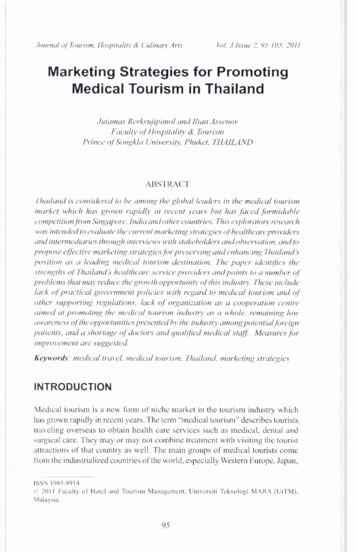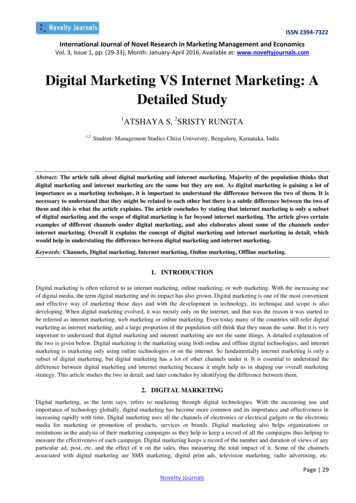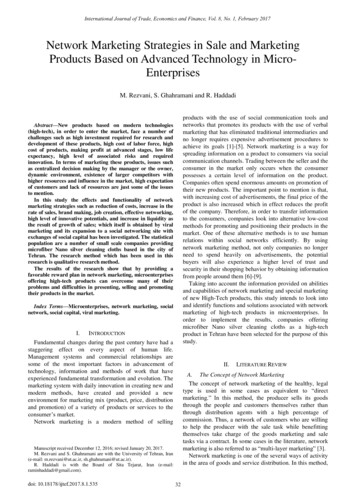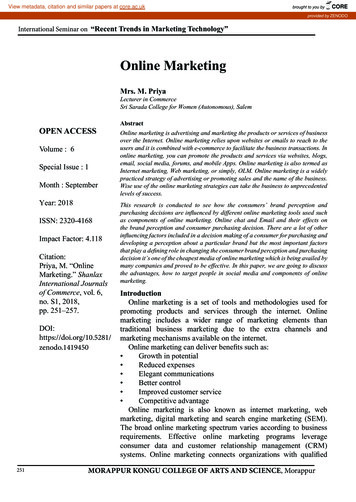
Transcription
Journal of Tourism, Hospitality & Culinary ArtsVol. 3 Issue 2, 95-105, 2011Marketing Strategies for PromotingMedical Tourism in ThailandJutamas Rerkrujipimol and Ilian AssenovFaculty of Hospitality & TourismPrince of Songkla University, Phuket, THAILANDABSTRACTThailand is considered to be among the global leaders in the medical tourismmarket which has grown rapidly in recent years but has faced formidablecompetition from Singapore, India and other countries. This exploratory researchwas intended to evaluate the current marketing strategies of healthcare providersand intermediaries through interviews with stakeholders and observation, and topropose effective marketing strategies for preserving and enhancing Thailand'sposition as a leading medical tourism destination. The paper identifies thestrengths of Thailand's healthcare service providers and points to a number ofproblems that may reduce the growth opportunity of this industry. These includelack of practical government policies with regard to medical tourism and ofother supporting regulations, lack of organization as a cooperation centreaimed at promoting the medical tourism industry as a whole, remaining lowawareness of the opportunities presented by the industry among potentialfbreignpatients, and a shortage of doctors and qualified medical staff. Measures forimprovement are suggested.Keywords: medical travel, medical tourism, Thailand, marketing strategiesINTRODUCTIONMedical tourism is a new form of niche market in the tourism industry whichhas grown rapidly in recent years. The term "medical tourism" describes touriststraveling overseas to obtain health care services such as medical, dental andsurgical care. They may or may not combine treatment with visiting the touristattractions of that country as well. The main groups of medical tourists comefrom the industrialized countries of the world, especially Western Europe, Japan,ISSN 1985-8914 2011 Faculty of Hotel and Tourism Managcmcnt, Univcrsiti Teknologi MARA (UiTM),Malaysia.95
Journal of Tourism, Hospitality & Culinary Artsthe U.S., Canada and Australia, where the cost of medical treatment is veryhigh and waiting times for some treatments may in some cases be months andeven years (Connell, 2006). Today's medical travel is mostly associated witheconomically less developed countries, such as Thailand, India, Singapore,Hungary, Costa Rica etc (Awadzi and Panda, 2006), which provide not onlylow-cost high-standard treatment, but also the opportunity of combining it witha vacation in a popular tourist destination.According to Suthin, Assenov and Tirasatayapitak (2007), the reasonsfor medical tourism gaining popularity in the above countries are as follows:1. The long waiting lists in the developed countries, 2. The low cost of medicaltreatments in medical tourism destinations, 3. The state-of-the-art technologyof health care services which have been adopted by the new service providers,4. Affordable international air fares, and 5. The advance of the Internet andthe emergence of new companies and agents to serve as middlemen betweeninternational patients and hospital networks which help patients to easily accessprice and any other information.Thailand has emerged in recent years as one of the leaders in the industry.Data collected from 30 private hospitals by the Department of Export Promotionof the Ministry of Commerce shows the increasing number of internationalpatients who have come to obtain medical treatment in private hospitals inThailand. In 1997 only 120,000 patients came for medical treatment; sincethen, the number has drastically increased to 975,532 in 2003 and 1,356,000in 2006 (see Figure 1).The main competitors in the medical tourism industry of Thailand in Asiaare: Singapore, Malaysia, India, and Hong Kong (Bangkok Bank, 2005). Thailandhas a number of competitive advantages: it is already a well-known touristdestination; it was one of the first countries to enter the medical tourism market;it is known for its unique culture of service — the renowned Thai hospitality;and also provides high quality services by qualified staff at a reasonable price.1,600,000 0,000,000—4— Number ofpatients0,19972003200420052006Figurel: Number of international patients in Thailand, 1997-2006Source: Data collected from 30 private hospitals by the Department of Export Promotion, Ministryof Commerce (cited in http://mrd-hss.moph.go.th/ac/download.asp)96
Marketing Strategies for Promoting Medical Tourism in ThailandUnder the guidance and regulation of the Ministry of Public Health, some Thaihospitals have been recognized and approved for the standards set by theHospital Accreditation of both Thailand and International (Joint CommissionInternational or JCI), and also other international standards such as ISO andHazards and Critical Control Points Principle (HACCP).The main competitors of Thailand in the region, as mentioned above, areIndia, Singapore and Malaysia. India, with its lower cost of health services,has emerged as an important competitor to Thailand. It had approximately150,000 patients in 2004 and the Indian government predicted that thisindustry could grow by l3% per year in the near future (Kaur, Sundar,Vaidya, and Bhargava, 2007). However, it still lacks the quality standardsand infrastructure, and suffers from a negative image due to the low hygieneand sanitation perception by travelers. Singapore has high living standards,there is strong government support for the medical tourism industry, Englishis widely spoken, and high quality medical services are offered at somewhathigher price than in Thailand, but are still much cheaper than in developedcountries. In 2006, 410,000 patients traveled to Singapore specificallyfor healthcare and the country hopes to attract 1 million medical travelersannually by 2012 (www.singaporemedicine.com ). Malaysia offers lowprices for healthcare services, and as a predominantly Muslim countryhas competitive advantages, in particular in attracting patients from theMiddle East (Tirasatayapitak, Suthin, and Assenov, 2007). According tothe Association of Private Hospitals Malaysia (cited in Advertising andPublicity Division, Tourism Malaysia, 2007), the number of internationalpatients seeking medical care in Malaysia has grown from 75,210 patientsin 2001 to 296,687 patients in 2006 when they generated USD 59 million inrevenue. Table 2, based on a publication by the Bureau of Policy and StrategyMinistry of Public Health (2007) of Thailand provides a comparison of thecountry with some of its major competitors.In order to face the challenges of growing competition, Thailand needs,among others, to improve its marketing of healthcare services. Therefore, thisresearch had the objectives of studying and observing the current marketingstrategies of service providers in medical tourism in Thailand (public hospitals,private hospitals, clinics, and medical travel agents) and related parties such asthe Ministry of Public Health, the Tourism Authority of Thailand (TAT), andthe Provincial Health Authority, and to analyze and evaluate the marketingstrategies of Thailand and its main competitors in the region (Singapore, India,and Malaysia) in order to come up with a proposal of effective marketingstrategies to develop and promote medical tourism in the country. This is thefirst such study carried out in Thailand, and is expected to enhance knowledgeas well as to contribute to the development of effective planning in the futureand to enhance the co-operation between stakeholders.97
Journal of Tourism, Hospitality & Culinary ArtsTable 2: Competitive advantages: Thailand & Asian competitorsCompetitive AdvantageThailand Singapore India Malaysia Hong KongService & HospitalityxxxxxHi-technological HardwarexxHR QualityxxxxInternational Accredited Hospital xxPre-emptive MovexxSynergy/Strategic PartnerxAccessibility/Market ChannelxxReasonable xxxxxxxxxxxxxxxxSource: Bureau of Policy and Strategy, Ministry of Public Health, 2007 (retrieved OLOGYThis qualitative research employed semi-structured interviews to examine thecurrent marketing strategies of Thailand's medical tourism service providers.Interviews took place with healthcare service providers (public hospitals, privatehospitals, and clinics), medical travel agents and related parties, at severalpopular tourism destinations of Thailand: Bangkok, Phuket, Pattaya, and KohSamui. Respondents were selected through purposive sampling, based oninformation from secondary data and the researchers' experience in the area, aswell as observation of healthcare providers' websites. Criteria for inclusion in theinterview list included: membership in the Thailand Private Hospital Association,the high number of international patients who received medical treatment,active marketing on the Internet, and non-medical care service provided to thepatients. The interview topics included questions related to current and futuretarget markets and marketing strategies, channel distribution, positioning, maincompetitors, threats to medical tourism in Thailand, industry collaboration,involvement of new stakeholders, medical travel packaging, and other relevanttopics. In addition, observation of stakeholders' websites and online marketingof service providers of competitors (Singapore, India, and Malaysia) were usedto accomplish the second objective of the study.RESULTS AND DISSCUSSIONThe findings from the interviews with the healthcare service providers andobservation of stakeholders' websites about the current marketing strategies usedby Thailand's health care service providers are described based on the 7 Ps of98
Marketing Strategies for Promoting Medical Tourism in Thailandthe marketing mix proposed by Kotler and Armstrong (2008) and the CharteredInstitute of Marketing (2005): Product, Price, Place, Promotion, People, Process,and Physical Evidence.ProductThailand's healthcare service providers offer specialized treatments such ascardiovascular, cosmetic or plastic surgery, dental care, gender reassignment,general surgery, ophthalmology, orthopedics, and health checks in accordancewith the needs of the patients in each target market. Well-trained medical staffand specialists and cutting-edge technology are used to reassure patients aboutthe standard and high quality of medical treatment. The quality of treatment ina less developed country is the major concern raised by the medical travelersfrom industrialized countries. Most respondents commented that Thailandis still considered a developing country among Westerners, especially thosewho have never been in the country before, so the availability of high qualitymedical care services is not easily recognized — unlike Singapore, with itspositive image as a high living standards country. However, the results ofthe previous research of Suthin, Assenov and Tirasatayapitak (2007) aboutsatisfaction with the health service in Thailand indicated that most of thepatients who had been treated were very satisfied with the facilities of thehospitals, the medical staff's professionalism, and quality of medical treatmentsand were willing to recommend these to their friends/relatives and spreadword of mouth information to more potential patients. Another marketingstrategy used by service providers is to create more value through services todifferentiate themselves from their increasing number of competitors. Suchservices include developing and intensifying customer relationships throughoffering medical transportation both on land and air, serviced apartments forpatients' relatives, cafes and restaurants, online immigration service, servicesfor translating different kinds of languages, individual personal care services,one-to-one nursing care service, online services for medical arrangements,contact center, patient center, hotel selection, reservation, sightseeing tourservices, interne and WiFi services, etc. The unique culture and the inborncharacteristic of genuine hospitality of the Thai people are highly regardedamong the foreigners and are special and difficult to find in other countries.The quality of Thai hospitality and its importance in differentiation were alsoconfirmed in reports by the Bureau of Policy and Strategy, Ministry of PublicHealth (2007), and the Boston Consulting Group (2008).PriceThailand's healthcare service providers have a competitive advantage due to theirhigh standard of medical treatment and services offered to the patients at a very99
Journal of Tourism, Hospitality & Culinary Artscompetitive price. Singapore offers medical treatment at a higher price thanThailand because of its positioning with high end complex quality acute care(Boston Consulting Group, 2008). India offers lower prices than Thailand butstill has the negative image of poor hygiene and sanitation. Kaur et al. (2007)stated that in India complicated medical procedures are being carried out at onlyone tenth of the cost in industrialized countries, but in terms of infrastructurefacilities such as roads, sanitation, power backups, accommodation, and publicutility services much more is needed for the country to become a medicaltourism destination. Malaysia offers prices lower than Thailand, partly dueto the favorable exchange rate but its focus is mainly on the Muslim patientsfrom Indonesia, Brunei and the Middle East.While costs themselves are competitive enough, problems arise fromovercharging and overpricing of treatments by some Thai healthcare serviceproviders. Some patients complain of hidden costs that are not announced inadvance. The costs of medical services are also rising due to the high taxes onimported medical technology or equipment. Therefore, the government has tocome up with a tax incentive policy which can not only solve the issue of thecost but further encourage the healthcare service provider in the developmentand implementation of high quality products and services. A good example isgiven by the Malaysian government which provides tax incentives for buildinghospitals, using medical equipment, training, promoting services, etc. toencourage development of the healthcare industry (Leng, 2007).PlaceThe internet is the main means for disseminating information related tohealthcare services offered by Thai healthcare service providers. It is the mosteffective and inexpensive way to reach its target customers with its productdirectly and at the same time help the patients acquire correct and valuableinformation and allow them to make an informed decision. Informative onlinemarketing of each service provider creates awareness of the medical treatmentavailable and reassures potential patients. Interactive communication, treatmentdescription, description of services and facilities, quality assurance and otherconcierge services are used on the websites to attract the patients who are ona medical traveling program. At the moment Thailand does not have a centralorganization to publicize valuable information on the health care servicesto medical travelers. Singapore established an outstanding website www.singaporemedicine.com as the center of the country's healthcare services. Itaims at promoting Singapore as a world class medical tourism destination, andhas proved very successful in this respect. The Thai government should supportor set up an official central website which combines all major healthcareservice providers together, for a focused promotion of medical tourism inThailand to the international market. Such a website would provide information100
Marketing Strategies for Promoting Medical Tourism in Thailandon treatment, facilities, links to healthcare service providers, medical travelagents, and could handle inquiries from overseas patients.Agents in the target countries are also used as representatives to provideinformation and advice to patients on their treatment. The agents work asthe center between patients and hospitals for screening cases, sending allnecessary medical reports of the patients to the hospitals, spreading word ofmouth information, serving as a source of assurance, proving the reliability ofhospitals, etc. Some respondents expressed concerns about the services of themedical travel agents, with regard to low accuracy in the medical correspondenceand over-promising to the patients which both lead to patients' subsequentdissatisfaction and create a negative image of the medical service provider.Therefore, healthcare service providers should choose high standard, professionaland ethical agent partners to promote their healthcare services as accurately aspossible. It is also recommended that the agent partners should be invited on afamiliarization visit by the healthcare service providers in order to be able todisseminate correct and valuable information to the medical travelers.PromotionAttending trade fairs, travel markets/travel fairs, exhibitions, seminars andconferences were used by the health care service providers to communicatetheir products and services to the customers. Some of the trade fairs, travelmarkets/travel fairs, and exhibitions were organized in cooperation with TAT,the Ministry of Foreign Affairs, and the Department of Export Promotion (DEP).But some providers participated on their own or with local organizations, localinstitutes, medical schools, and universities in those target countries to establishcollaboration and to promote the available medical care services. Observationsindicated that the strategies to provide various information resources andpromotional services were implemented on the websites, so that patients seekingmedical treatments abroad could regularly visit to discover medical servicepromotions, the latest developments of the medical service providers and alsoto gain confidence in using their services in Thailand. The government and TATshould come up with various supports and encourage more health care serviceproviders to participate in the trade fairs, travel markets and exhibitions in orderto promote their products and services. Moreover the media, journalists, travelwriters and book writers should be used to as a tool to develop a positive imageabroad. These could be invited for a free trip to the country and to specificmedical facilities. A strong network into overseas countries, e.g. through jointventure partnerships, is also a measure to build the image of the products andservices of the Thailand. It is recommended that the Thai government and thehealthcare service providers cooperate more and work together in maintainingthe current standard of high quality products and services and further developand expand the image of the country as the "Medical Hub of Asia".101
Journal of Tourism, Hospitality & Culinary ArtsPeopleAnother strategy that health care service providers use to attract the internationalpatients for their treatments in Thailand is to emphasize its well-trainedmedical specialists, with degrees from well-known overseas institutes. It wasacknowledged by all the health care service providers that having specializedand qualified doctors and staff proved a competitive advantage for the hospitals.This has been observed, for example on the websites of Bumrungrad hospital andBangkok hospital, where the qualifications of doctors and hospital nurses and themedical staff were intensively promoted to attract and capture potential patients.However, a shortage of doctors and trained medical staff was the major concerncurrently commented on by the respondents. Moreover, language communicationskills — sometimes of doctors, but more often of nurses, receptionists, andother relevant staff — and misunderstanding of the patients' culture were stillconsidered a problem and challenges for the medical tourism business for bothhospitals and clinics. Communication problems can lead to misunderstandingsbetween the patients and the medical staff and possibly to wrong diagnoses orunsuitable treatment. These issues need to be addressed immediately by the Thaigovernment and the health care service providers. Development of the educationcurriculum in the medical field should be emphasized and people encouragedto pursue and specialize in medical studies by offering various scholarships forstudies in the country and abroad.ProcessPatients who seek medical treatment abroad are mostly concerned with thequality of treatment and often want to make sure the hospital they select islicensed and preferably accredited by a recognized international organization thataudits medical quality. The process of acquiring an international accreditationwith Joint Commission International (JCI) is one of the marketing strategy toolsfor the health care service providers in Thailand. Such accreditation recognizesthat the practices of the doctors, nurses, medical assistants, the managementteam and the facilities of the hospital meet or exceed the standards of medicalfacilities in the US. The websites of the major hospitals aim to convince visitorsof the quality of the products, services and facilities through showing their awardsand accreditations such as JCI, ISO and others received from the internationalorganization and the government. So far in Thailand, Bumrungrad InternationalHospital, Samitivej Hospital, and Bangkok Hospital Medical Center haveattained JCI accreditation, compared to 11 hospitals in Singapore (accountingfor one-third of all JCI-accredited facilities in Asia), and eight hospitals inIndia (The Boston Consulting Group, 2008). There are other hospital assuranceschemes and awards which are also important to guarantee the quality of medicalcare services, such as Thailand Hospital Accreditation Program (HA) conducted102
Marketing Strategies for Promoting Medical Tourism in Thailandby the Institute of Hospital Quality Improvement & Accreditation, and ISO.In order to compete with the competitors both Government and Health careservice providers need to work in cooperation to further develop and enhancethe medical infrastructure, quality of products and services, management, etc.of many more hospitals and clinics which should acquire similar internationalaccreditations. This will not only increase the number of visitors but will boostthe image of Thailand as a medical tourism destination.Physical EvidenceHaving developed its healthcare industry actively relatively late, Thailand'shealthcare service providers have had the advantage of learning andunderstanding the needs and desires of patients better. The service providershave developed and constructed outstanding hospitals equipped with the latestadvanced technologies, good ambiance with spacious and luxurious rooms, andexcellent amenities. This provides a competitive advantage over other medicalproviders to market and gain the confidence of the patients in choosing thehospitals. It has been observed that major health care providers have developedsignificantly both infrastructures and facilities; however, there is still a need formany other service providers to improve their infrastructure and facilities.CONCLUSIONThe medical tourism industry in Thailand is still growing and expanding in spiteof the high competition. Both online and offline promotion tools were used tocreate awareness of the availability of high quality medical care and non-medicalcare services, reassure patients about the standards and quality of medicaltreatments, and offer alternative healthcare services for selection by potentialtarget customers. This research identified a number of other issues related tothe further promotion and expansion of the healthcare business in Thailand tothe overseas markets. These include the need for practical government supportand a common global strategy, adoption of appropriate laws and regulation,and facilitation in the visa extensions procedures. The need for more qualifiedspecialists and staff, language training, cross-cultural training, and positivePR for Thailand that remove the 'third-world country" image, the lack ofcollaboration among service providers and of an organization to work as thecentre in this area are other relevant issues identified.In order to maintain the high standards and to compete with the highcompetition emerging from new medical tourism destinations every year,the researchers hope that these issues will be given immediate attention andaddressed responsibly and appropriately by the Government, medical servicesprovider and the other related stakeholders in the near future.103
Journal of Tourism, Hospitality & Culinary ArtsREFERENCESAdvertising and Publicity Division, Tourism Malaysia. (2007). Media InfoHealth Tourism in Malaysia. Retrieved April 4, 2008, from: http://www Awadzi, W. & Panda, D. (2006). Medical Tourism: Globalization and theMarketing of Medical Services. The Consortium Journal, 11(1), 75-81.Boston Consulting Group. (2008). Overview of Medical Tourism — Give backdeck, BCG.Bureau of Policy and Strategy Ministry of Public Health. (2007). Health policyin Thailand 2007. Retrieved February 26, 2008, from: http://203.157.19.191/HealthPolicy7.pdfBangkok Bank. (2005). Health Products and Health Services: Another Industryin which Thailand is Competitive. Retrieved August 25, 2007, from:http://www.bangkokbank.com/download/Health Products and HealthServices.pdfChartered Institute of Marketing. (2005). Marketing and the 7Ps A brief summaryof marketing and how it works. Retrieved March 1, 2008 from: fConnell, J. (2006). Medical tourism: Sea, sun, sand and . surgery. TourismManagement, 27 (6), 1093-1100.Kaur, J., Sundar, G. H., Vaidya D., & Bhargava S. (2007). Health Tourism inIndia Growth and Opportunities. Proceedings, International MarketingConference on Marketing & Society. Retrieved September 2, 2007, /415-422.pdfKotler, R & Armstrong, G. (2008). Principles of Marketing. The USA: PearsonEducation, Inc.Leng, C. (2007). Medical Tourism in Malaysia: International Movement ofHealthcare Consumers and the Commodification of Healthcare. AsiaResearch Institute Working Paper Series No. 83. Retrieved July 29, 2007,from: http://www.ari.nus.edu.sg/showfile.asp?pubid 583&type 2104
Marketing Strategies for Promoting Medical Tourism in ThailandThailand Medical Tourism. Retrieved October 4, 2007, from: http://mrdhss.moph.go.th/ac/download.aspMedical Tourism inTirasatayapita k , A., Suthin, K., & Assenov, I. (2007).Japanese Tourists and Patients.Thailand: Meeting Better the Needs ofThailand: Prince of Songkla University.Suthin, K., Assenov, I. & Tirasatayapitak, A. (2007). Medical Tourism: Cansupply keep up with the demand. Proceedings, APac-CHRIE & Asia PacificTourism Association Joint Conference, Beijing, China.105
Keywords: medical travel, medical tourism, Thailand, marketing strategies INTRODUCTION Medical tourism is a new form of niche market in the tourism industry which has grown rapidly in recent years. The term "medical tourism" describes tourists traveling overseas to obtain health care services such as medical, dental and surgical care.










